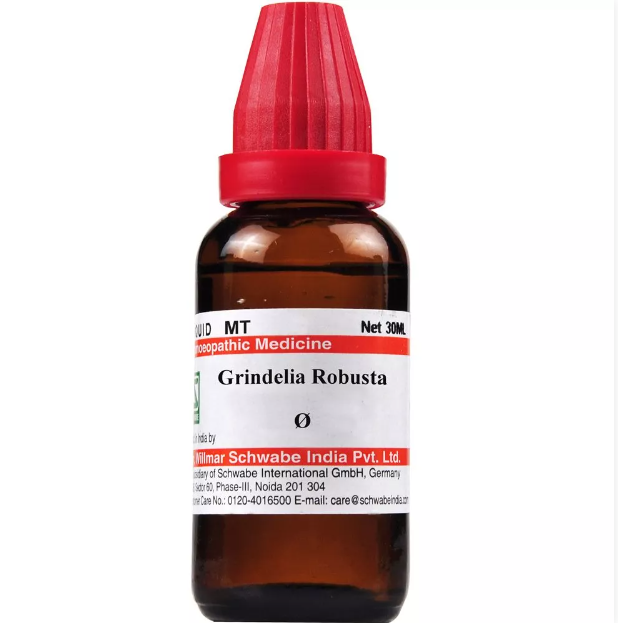GRINDELIA ROBUSTA Q, 6C, 12C, 30C, 200C, 1M, 10M USES AND SYMPTOMS
 GRINDELIA ROBUSTA
GRINDELIA ROBUSTA
(Rosin-wood)
Grin.
Both Grindelia robusta and Grindelia squarrosa are used for the symptoms described here, with no significant difference in their effects. Grindelia squarrosa is noted for more splenic symptoms, dull pains, and fullness in the left hypochondrium; chronic malaria; and gastric pains linked to splenic congestion. It causes paralysis, starting in the extremities, and affects the heart by initially speeding it up, then slowing it down.
It acts on the cardio-pulmonary distribution of the pneumo-gastric nerve in dry catarrh (Ant-t. in muco-purulent), causing paresis of this nerve and interfering with respiration. Symptoms include smothering after falling asleep, asthmatic conditions, chronic bronchitis, and bronchorrhea with tough mucus that is hard to detach. It raises blood pressure, causes nausea and retching from gastric ulcers, and treats diabetes. It is an effective antidote for Rhus poisoning (both locally and internally), burns, blisters, vaginal catarrh, and herpes zoster. It is also helpful for hyperchlorhydria with asthmatic and neurotic symptoms and hyperemia of the gastric mucosa with difficult respiration.
Head: Feels full, as from quinine.
Eyes: Pain in the eyeballs, radiating to the brain; worse with eye movement. Pupils dilated. Purulent ophthalmia and iritis.
Abdomen: Cutting pains in the spleen area, extending to the hips. Splenomegaly (Cean., Card-m.).
Respiratory: Effective for wheezing and oppression in bronchitic patients, with sibilant rales and foamy, hard-to-detach mucus. Acts on pulmonary circulation. Relieves asthma with profuse, tenacious expectoration. Stops breathing after falling asleep, causing the person to wake up with a start and gasp for breath. Breathing is only possible when sitting up. Pertussis with profuse mucus secretion (Coc-c.). Bronchorrhea with tough, whitish mucus. Sibilant rales. Weak heart and respiration. Cheyne-Stokes respiration.
Skin: Rash-like roseola with severe burning and itching. Vesicular and papular eruptions. Herpes zoster with itching and burning. Treats poison oak (as a wash), and ulcers with swollen, purplish skin.
Relationship: Compare with Ant-t., Erio., Lach., Sang.
Dose: Tincture in 1 to 15 drop doses, also lower potencies.
SYMPTOMS OF GRINDELIA ROBUSTA
Head:
Fullness, as from quinine.
Eyes:
Pain in the eyeballs, radiating to the brain (worse with eye movement).
Dilated pupils.
Purulent ophthalmia and iritis.
Abdomen:
Cutting pains in the spleen area, extending to the hips.
Splenomegaly.
Respiratory:
Wheezing and oppression in bronchitic patients.
Sibilant rales with foamy, hard-to-detach mucus.
Asthma with profuse, tenacious expectoration.
Stops breathing after falling asleep, causing the person to wake up with a start and gasp for breath.
Breathing only possible when sitting up.
Pertussis with profuse mucus secretion.
Bronchorrhea with tough, whitish mucus.
Weak heart and respiration.
Cheyne-Stokes respiration.
Skin:
Rash-like roseola with severe burning and itching.
Vesicular and papular eruptions.
Herpes zoster with itching and burning.
Treats poison oak (as a wash).
Ulcers with swollen, purplish skin.
selection of the potency
Individualization:
- Homeopathy is based on the principle of treating the individual, not just the disease. The unique symptoms and characteristics of the person are crucial in determining the most suitable potency.
Intensity of Symptoms:
- The intensity of the symptoms guides the choice of potency. If the symptoms are intense and acute, a lower potency (e.g., 6C, 30C) might be considered. For chronic conditions with less intensity, higher potencies (e.g., 200C, 1M) may be appropriate.
Sensitivity of the Patient:
- Some individuals are more sensitive to homeopathic remedies, while others may require higher potencies. The practitioner considers the patient’s sensitivity when selecting the potency.
Acute vs. Chronic Conditions:
- Lower potencies are often used for acute conditions, while higher potencies may be considered for chronic or long-standing issues.
Previous Response to Potencies:
- The patient’s response to previous homeopathic treatments helps guide the choice of potency. If a particular potency has been effective in the past, it may be repeated or adjusted as needed.
Vital Force and Susceptibility:
- Homeopathy views illness as a disturbance in the vital force. The practitioner assesses the patient’s overall vitality and susceptibility to determine the appropriate potency.
Aggravation or Amelioration:
- The direction of the symptom response (aggravation or amelioration) after taking a remedy can influence the choice of potency.
Miasmatic Considerations:
- In classical homeopathy, the concept of miasms (inherited disease tendencies) is considered. The practitioner take this into account when selecting the potency.
Practitioner Experience:
- The experience and preference of the homeopathic practitioner play a role. Some practitioners may have success with certain potencies based on their clinical experience.
SAFETY INFORMATION
- Do not exceed the recommended dose by physician
- Keep out of the reach of children
- Store in a cool dry place away from direct sunlight
- Maintain half an hour gap between food/drink/any other medicines and homoeopathic medicine
- Avoid any strong smell in the mouth while taking medicine e.g. camphor, garlic, onion, coffee, hing
Medicine images use for reference only selection of homeopathic medicine depends on the individual’s specific symptoms and overall constitution. Moreover, homeopathy is a holistic system of medicine that treats the individual as a whole. In addition to addressing the physical symptoms, it takes into account the emotional and mental state of the person. Consequently, it’s crucial to consult with a qualified homeopathic practitioner for personalized treatment.
The information provided on this website is intended solely for educational purposes. Always seek the advice of your physician or other qualified health provider.
